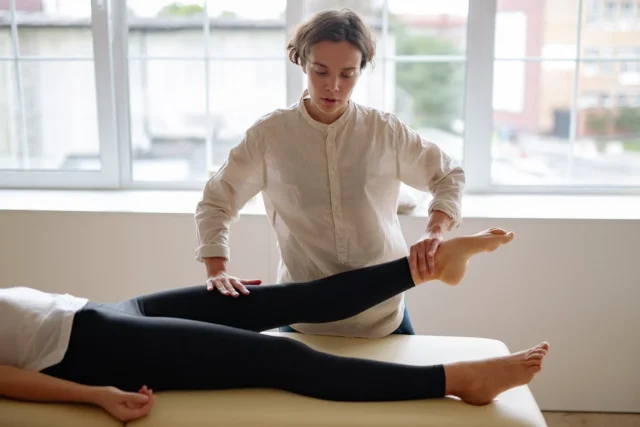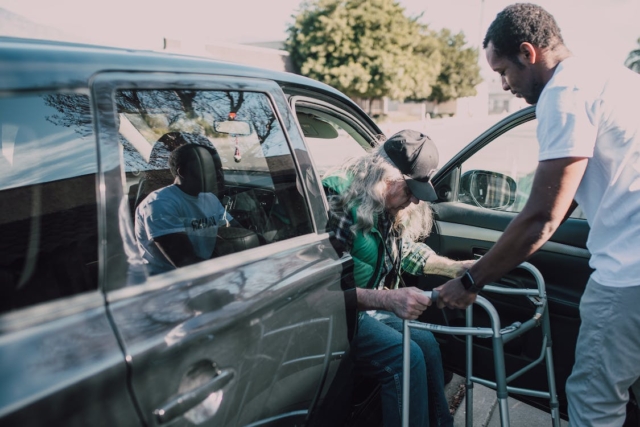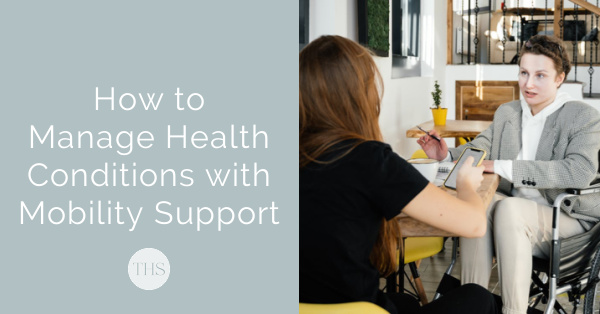Buffer Time: The Missing Ingredient of Pacing with Chronic Illness

This article is written by Evan Drake.
Mobility support is a game changer for people with chronic health problems, turning daily challenges into smoother routines. Think steadier walks and safer homes.
We’ll unpack how chronic diseases like Parkinson’s can throw a wrench in movement, but also show you the power of tailored exercises from therapists to keep things flowing. From grab bars to smart medication management, we’ve got your back on boosting independence and dodging falls. Plus, staying socially plugged in despite physical limits? We’re on it.
Ready for some life-enhancing moves? Let’s roll!
As you age, mobility issues can sneak up on you like a quiet thief, as well as result from conditions we hear about daily—arthritis and Parkinson’s disease are the usual suspects. These aren’t just buzzwords; they’re real challenges that significantly alter your ability to waltz through their day-to-day life.
The link between chronic diseases and mobility isn’t just strong—it’s as solid as the ground under our feet. Imagine arthritis turning simple hand movements into a strenuous task or Parkinson’s making one feel like they’re walking through molasses. That’s an everyday reality for some seniors and chronically ill people, and it takes more than willpower to keep moving forward.
But muscle weakness also plays its part, creeping in slowly until climbing stairs feels like scaling Mount Everest without a sherpa. It doesn’t have to be this way though—with proper help, including tailored exercise plans focusing on strength and flexibility, you can reclaim some of your former agility.

Physical and occupational therapists bring a unique blend of expertise to the table, tailoring exercise programs that go beyond one-size-fits-all solutions. They are like personal trainers with medical degrees—keen on boosting your strength and flexibility but also armed with clinical insights into managing chronic conditions. You can also explore our guide on dealing with chronic back pain.
If you’ve ever tried a generic workout plan and found it lacking, you’ll appreciate how therapists craft exercises specifically for your needs. These aren’t just random stretches; they’re strategic moves aimed at shoring up muscle weakness without overdoing it. It’s all about finding that sweet spot where movement becomes medicine.
A therapist knows too well that arthritis isn’t just stiffness—it can feel like trying to salsa dance while wading through molasses. But they also know exactly what can help cut through the gunk: personalized routines designed not only to get you moving more smoothly but safely as well, reducing those pesky fall risks that loom large as we age.
Imagine the freedom of gliding through your home, unhindered by the limitations that once kept you tethered to a single room. Mobility aids aren’t just tools; they’re keys to unlocking a safer, more independent life. Wheelchairs offer comfort and efficiency on longer journeys around town or even just navigating the garden without worry.
Walkers bring stability with every step, providing balance where it’s most needed and turning potential hazards into mere obstacles easily overcome. Then there are grab bars – silent guardians in bathrooms and hallways that lend their strength when rising from a chair or stepping out of the shower, which becomes its own adventure.
The truth is clear: these mobility aids do much more than serve their primary functions; they rebuild confidence and encourage autonomy in daily activities. And let’s not forget how essential this can be for mental health as well. They act as steadfast companions ensuring safety while fostering an environment where living alone doesn’t have to mean feeling alone. In this pursuit of independence and well-being, Restore Mobility offers a range of products designed to meet individual needs, enhancing mobility with innovative solutions that support a more active and fulfilling lifestyle.
Think about it: your muscles are like a classic car. To keep that car running smoothly and to avoid any unwanted breakdowns, you’ve got to take it out for a spin regularly. That’s exactly what regular exercise does —it keeps everything in tip-top shape.
Walking programs are not just strolls in the park; they’re muscle fortifiers and flexibility enhancers all rolled into one. With consistent physical activity, you can hold onto your independence because stronger muscles mean less risk of taking an unexpected tumble.
But let’s get real—exercise isn’t just about avoiding falls. It’s also about reclaiming life and doing things on your own terms. When those legs get moving, they’re telling gravity who’s boss—one step at a time.

Mobility challenges can turn simple daily tasks into daunting hurdles. But there’s a silver lining: caregivers and support groups offer a beacon of hope, lighting the way to improved movement and quality of life. These support systems aren’t just nice to have; they’re vital in keeping spirits high and bodies moving.
When navigating your home feels like an obstacle course, that’s where caregivers step in – not only providing help but also becoming trusted companions on the journey towards better mobility. And let’s talk about support groups – these are no ordinary meetups. They’re gatherings where stories are shared, advice is exchanged, and motivation multiplies faster than bunnies.
These networks don’t just give moral boosters; they arm you with strategies to manage chronic conditions that often go hand-in-hand with mobility issues. So yes, behind every senior standing tall or chronically ill person cruising smoothly down the sidewalk could very well be a rockstar caregiver or empowering group chats cheering them on.
Making your home a safer place doesn’t have to look like a scene out of a hospital drama. With some smart tweaks here and there, you can boost safety without sacrificing style. Imagine this: grab bars that double as towel racks or sleek, sturdy railings that blend right into your hallway’s decor.
We’re not just talking about aesthetics; these changes are lifesavers. Good arch support in shoes is one thing but think about it – the floors you walk on need to keep up too. Slip-resistant flooring isn’t only for professional kitchens; it can be part of your chic bathroom makeover too. You get peace of mind with every step and an Instagram-worthy space.
So let’s ditch those tripping hazards—like that sneaky area rug—and make sure each room has ample lighting because no one should play guessing games with furniture placement at night. Small changes, big impact—that’s how we roll when it comes to preventing falls at home.
Mobility issues can throw a wrench in the works of daily life, especially when they stem from conditions that are already tough to manage. Think arthritis or Parkinson’s disease; these aren’t just minor speed bumps—they’re like rush-hour traffic jams on your body’s highway system. But here’s a bright spot: managing your meds right can help clear up some of that congestion.
Treating chronic diseases is more than just swallowing pills—it’s about keeping them organized and taken at the right times to avoid collisions and pile-ups in treatment effectiveness. For those grappling with movement restrictions, it means having one less thing to worry about as their medication helps ease pain, reduce inflammation, or give nerves the green light they need.
When we talk about safety and independence for seniors and chronically ill people, mobility aids such as wheelchairs or walkers often steal the spotlight. Yet proper pill popping—by which I mean consistent and correct medication intake—is equally essential for steering clear of additional health problems down the road.

Think of health screenings as your personal intel on the battle against musculoskeletal conditions. They’re like undercover agents, silently scanning to catch any potential threats early, giving you a better shot at managing them before they become too formidable.
Muscle weakness isn’t just about struggling to open jars or needing help carrying groceries; it’s a sign that something bigger may be looming on the horizon. And here’s where regular check-ups come into play—they keep an eye out for these and other health issues so you can tackle them head-on. The goal? To stay one step ahead in maintaining your mobility and independence.
It’s not all cloak-and-dagger though—these screenings are straightforward ways to protect your well-being. With timely detection through health checks, seniors have a fighting chance to address concerns early, potentially easing the journey down the road with proactive management strategies tailored just for them.
Mobility challenges can turn the simple act of stepping out for a coffee into an ordeal, but that doesn’t mean social life has to end. Let’s explore how technology and community programs offer lifelines.
The digital world throws open its doors wide for those facing mobility issues. Imagine catching up with (grand)kids via video calls or joining book clubs online—this is today’s reality thanks to platforms like Zoom and Skype. It’s not just about seeing loved ones; it’s also about rekindling friendships long-distance or discovering communities with shared interests on Facebook groups.
But let’s not forget accessibility tools. Voice recognition software turns speech into text messages, letting conversations flow without the need for travel. With technology helping people with chronic illness stay connected, loneliness takes a back seat while independence drives forward.
Wrapping it up, managing health conditions with mobility support is all about staying active and safe. Remember those chronic diseases? They can mess with movement but don’t let them win. Tailored exercises are your secret weapon. Aids like wheelchairs and grab bars? Think independence boosters. Throw in some home tweaks to cut down on fall risks, and you’re playing it smart.
And never underestimate the power of a good chat or video call to keep spirits high despite physical hurdles. That’s how community ties stay strong. In short: move well, live better, and stay connected. Let these be your mantras for thriving at any age.
Learn more how you can improve your functional fitness and walking stamina, as well as the small home upgrades you could make for better accessibility.